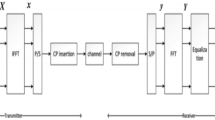Abstract
Radio over Fiber (RoF) is a promising technology for extending broadband wireless access to indoor and outdoor dead spots. However, commonly applied intensity-modulation / direct-detection RoF transmission presents some nonlinearity and produces echo distortion. Since multiple carrier modulation signals such as Orthogonal Frequency Division Multiplexing (OFDM) are widely employed in broadband wireless systems, the above issues become more serious. The OFDM signals have high Peak-to-Average Power Ratio, which makes them more sensitive to nonlinearity. Moreover, the large delay of optical echoes that are caused by the discontinuity of refractive index at both ends of Electrical/Optical (E/O) and Optical/Electrical converters exceeds the guard time of current OFDM symbols when the length of optical fiber is long. Since the nonlinearity and echo exist simultaneously in RoF channels, their composite effect is mathematically analyzed in this paper. A RoF-echo model is proposed for the modeling of the multiple light reflections and its validity is confirmed by experiments. Then, Envelop-Pulse-Width-Modulation- (EPWM-) RoF transmission is proposed for dealing with the nonlinearity and echo in RoF channel. The performance of the EPWM-RoF scheme for OFDM signal transmission is evaluated by simulations, which reveals that the scheme improves the transmission quality in Error Vector Magnitude under the composite environment of E/O nonlinearity and optical echo.










Similar content being viewed by others
References
Agrawal, G. P. (2002). Fiber-optic communications systems (3rd ed.). New York: John Wiley & Sons, Inc.
Choi, W., & Andrews, J. G. (2007). Downlink performance and capacity of distributed antenna systems in a multicell environment. IEEE Transactions on Wireless Communications, 6(1), 69–73.
Nee, R. V., & Prasad, R. (2000). OFDM for wireless multimedia communications. Norwood, MA: Artech House.
Nader, C., Landin, P. N., Moer, W. V., Björsell, N., & Händel, P. (2011). Performance evaluation of peak-to-average power ratio reduction and digital pre-distortion for OFDM based systems. IEEE Transactions on Microwave Theory and Techniques, 59(12), 3504–3511.
Yu, X., Matsuura, M., & Yamao, Y. (2014). EPWM-OFDM signal transmission against nonlinearities of E/O converters in radio over fiber channel. IEICE Transactions on Communications, E97–B(2), 484–494.
Thompson, S. C., Ahmed, A. U., Proakis, J. G., Zeidler, J. R., & Geile, M. J. (2008). Constant envelope OFDM. IEEE Transactions on Communications, 56(8), 1300–1312.
Pepeljugoski, P. K., & Lau, K. Y. (1992). Interferometric noise reduction in fiber-optic links by superposition of high frequency modulation. Journal of Lightwave Technology, 10(7), 957–963.
Moslehi, B. (1986). Noise power spectra of two-beam interferometers induced by the laser phase noise. Journal of Lightwave Technology, LT–4(11), 1704–1709.
Umali, E., Toyama, Y., & Yamao, Y. (2007). Delta-sigma envelope Pulse-Width Modulation (EPWM) transmitter for high efficiency linear amplification. IEICE Technical Report, RCS2007-103 (pp. 37–42).
Umali, E. M., Kawazoe, K., & Yamao, Y. (2010). Quantization noise and distortion analysis of envelope pulse-width modulation (EPWM) transmitters for OFDM signal amplification. IEICE Transactions on Fundamentals of Electronics, Communications and Computer Sciences, E93–A(10), 1724–1734.
Schreier, R., & Temes, G. (2005). Understanding delta-sigma data converters. New York: A John Wiley & Sons, Inc.
Roerich, D., Wang, X., Bernhard, M., & Speidel, J. (2013). Optimal modulation index of the in a coherent optical OFDM system employing digital predistortion. In Proceedings ITG Symposium on Photonic Networks (pp. 1–6).
Ng, W. P., Loedhammacakra, W., Ghassemlooy, Z., & Cryan, R. A. (2008). Characterisation of a parallel optical all pass filter for chromatic dispersion equalisation in 10 Gb/s system. IET Circuits, Devices & Systems, 2, 112–118.
Mortimore, D. B. (1988). Fiber loop reflectors. Journal of Lightwave Technology, 6(7), 1217–1224.
Acknowledgments
This work was supported by the Ministry of Internal Affairs and Communications (MIC) of Japan under the SCOPE Program #135003118 in Year 2013.
Author information
Authors and Affiliations
Corresponding author
Rights and permissions
About this article
Cite this article
Yu, X., Matsuura, M. & Yamao, Y. Composite Effect of E/O Nonlinearity and Optical Echo on EPWM-OFDM Transmission in Radio Over Fiber Channel. Wireless Pers Commun 93, 647–660 (2017). https://doi.org/10.1007/s11277-014-2219-8
Published:
Issue Date:
DOI: https://doi.org/10.1007/s11277-014-2219-8




